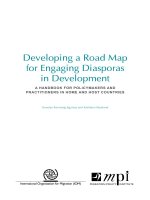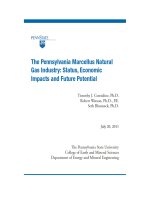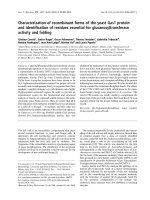FEBRUARY 2008 Policy Brief: ORGANISATION FOR ECONOMIC CO-OPERATION AND DEVELOPMENT pot
Bạn đang xem bản rút gọn của tài liệu. Xem và tải ngay bản đầy đủ của tài liệu tại đây (211.61 KB, 8 trang )
© OECD 2008
ORGANISATION FOR ECONOMIC CO-OPERATION AND DEVELOPMENT
Policy Brief
FEBRUARY 2008
Health and the Environment
Introduction
How much does the environment affect human health? Are air pollution
and tainted water shortening our lives and those of our children? These
questions have aroused increasing interest in recent years, particularly
since the adoption of Agenda 21 at the UN Conference on Environment and
Development, which drew the attention of policy makers to the links between
health and the environment.
Air pollution is one obvious environmental health threat in OECD countries,
contributing to a number of illnesses, such as asthma and in some cases
leading to premature death. Of particular concern is the fact that children
are more vulnerable to air pollution than adults, and increased rates of infant
mortality have been recorded in highly polluted areas.
Concerns about the impact of air pollution on health and the economy have
resulted in measures to mitigate emissions of the most harmful pollutants,
such as particle pollution (acids, organic chemicals, metals, and soil or dust
particles) and ozone, which affects the respiratory system. Despite national
and international interventions and decreases in major pollutant emissions,
the health impacts of air pollution are not likely to decrease in the years
ahead, unless appropriate action is taken.
Water is another key environmental health issue – unsafe drinking water and
untreated waste water kill thousands of people a year, most of them children.
Other health issues associated with emerging environmental hazards, such
as chemical products, will also need to be addressed. Chemical products
are used in virtually every man-made product and play an important role in
the everyday life of people around the world. However, harmful exposure to
chemical products can lead to health problems such as skin diseases, chronic
bronchitis, nervous system dysfunctions and cancers as well as damaging the
environment.
What should be done to better address environmental health risks? This
Policy Brief proposes some answers as well as possible policy directions. ■
How does pollution
affect health?
What does
environmental
degradation cost
our health?
What environmental
policies are needed?
Where do we
go from here?
For further
information
For further reading
Where to contact us?
2 ■ © OECD 2008
Policy Brief
HEALTH AND THE ENVIRONMENT
Environmental degradation exerts significant pressure on human health.
Exposure to air, water and soil pollution, to chemicals in the environment,
or to noise, can cause cancer, respiratory, cardiovascular and communicable
diseases, as well as poisoning and neuropsychiatric disorders.
Outdoor air pollution is a major environmental problem in OECD countries. It
can have acute health effects resulting from short-term exposure or chronic
health impacts resulting from long-term exposure. Health problems linked to
air pollution range from minor eye irritation to upper respiratory symptoms,
chronic respiratory diseases such as asthma, cardiovascular diseases and
lung cancer. Some of these require hospital treatment, and may be fatal.
How badly air pollution affects individuals will depend on the pollutant’s
chemical composition, its concentration in the air, the length of exposure,
the synergy with other air pollutants, as well as individual susceptibility
(Box 1). Although environmental risk factors can affect the health of the
whole population, some groups are particularly vulnerable to environmental
pollution, including children, pregnant women, the elderly and persons with
pre-existing diseases.
Although the direct health effects of exposure to chemicals are complex
and sometimes open to debate, health problems due to harmful exposure
to some chemicals are well documented. For instance, concern has been
raised about the link between exposure to chemicals such as alkylphenols
(used in detergents and pesticides) and disruption of the hormonal system
that regulates many of the body’s functions. Effects on sperm motility, foetal
growth rate and neurological functions of offspring have been observed from
human exposure to PCBs, and epidemiological studies suggest exposure-related
increases in cancers of the digestive system. PCBs were used in coolants,
How does pollution
affect health?
Box 1.
CHILDREN’S HEALTH
AND THE ENVIRONMENT
Children are more susceptible to environmental pollution than adults. Metabolic
activity is higher in children as their bodies are still developing. Children’s bodies
respond differently than adults’ to the same apparent levels of exposure and are less
able to metabolise or remove pollutants. Moreover, adults and children are exposed
to different types of risk, mainly because of their different activities. Children tend
to spend more time outdoors and are more exposed to soil and outdoor air pollution.
They are also less aware of the environmental risks surrounding them. So children
can be exposed to higher levels of pollution than adults.
Examples of impacts of environmental pollution on children’s health include:
• cancer (e.g. skin cancer from exposure to UV radiation or leukaemia resulting from
exposure to pesticides while still in the womb)
• asthma (exacerbated by outdoor air pollution)
• birth defects (from drinking-water contaminants ingested by the pregnant mother)
• neurodevelopmental disorders (resulting from lead poisoning)
Despite a large number of measures undertaken in OECD countries to protect
children’s health from environmental hazards, most existing environmental
legislation does not take account of children’s specific vulnerability to the various
environmental risks.
© OECD 2008 ■ 3
HEALTH AND THE ENVIRONMENT
Policy Brief
insulating fluids, PVC and other products until their production was banned in
most countries the 1970s; even so they are still found in the environment.
Poor water supply, sanitation and hygiene (WSH) is another environmental
source of ill-health. Inadequate sewage treatment and poor sanitation
result in diarrhoeal diseases caused by bacteria, such as cholera or E. coli,
by viruses such as norovirus or rotavirus or protozoan parasites such as
cryptosporidiosis or giardiasis. The greatest health risk in this area comes
from unsafe drinking water. ■
Evidence suggests that environmental problems can have a substantial
impact on human health. Unsafe water supply, sanitation and hygiene
are responsible for 3% of all deaths and 4.4% of all years of life lost (YLL)
worldwide. But the poorest developing countries are the worst affected; 99%
of these deaths occur in non-OECD countries and 90% of those dying are
children. Although the health impacts of water-related diseases remain very
low in OECD countries (around 0.2% of deaths), some OECD countries are
affected more than others (Figure 1).
In Brazil, Russia, India, Indonesia, China and South Africa (BRIICS), unsafe
WSH was responsible for 2.2% of all deaths and 3.5% of the total burden of
disease in 2002 – of which 87% occurred in India and China. When these
figures are adjusted for population size, deaths from unsafe WSH in the rest
of the world are 40.5 times higher than in OECD countries, and 2.7 times
higher than in the BRIICS.
At the global level, air pollution is estimated to be responsible each year for
approximately 800 000 premature deaths, or 1.4% of all deaths worldwide and
6.4 million years of life lost, or 0.7% of the world total. This burden of disease
is most important in developing countries, causing an estimated 39% of years
of life lost in south-east Asia (e.g. China, Malaysia, Viet Nam) and 20% in other
Asian countries (e.g. India, Bangladesh).
What does
environmental
degradation cost
our health?
Figure 1.
MORTALITY AND
BURDEN OF DISEASE
DUE TO UNSAFE WATER,
SANITATION AND
HYGIENE, 2002
Source: Prüss-Üstün et al., 2004.
0
1
2
3
4
5
6
7
%
Korea Mexico Turkey OECD BRIICS Rest of the
worl
d
Deaths YLL
4 ■ © OECD 2008
Policy Brief
HEALTH AND THE ENVIRONMENT
PM
10
– tiny particulate matter small enough (PM) to be inhaled into the
deepest part of the lung – is especially harmful to human health, as it
can substantially reduce life expectancy. For the year 2000, exposure to
PM
10
caused approximately 960 000 premature deaths and 9.6 million YLL
worldwide. At least 80% and in some areas more than 90% of these deaths
were associated with cardiopulmonary diseases.
The OECD projects an increase in premature deaths for most world regions
between now and 2030 (see Figure 2), even for areas where PM
10
levels are
estimated to decrease (for example, Asia and Brazil). This is because of other
factors, such as increasing urbanisation and ageing of the population (the
elderly being more vulnerable to air pollution). In 2030, premature deaths
from lung cancer are projected to be multiplied by four, but premature deaths
from acute respiratory infection in children would decrease both in absolute
and relative numbers. The total number of premature deaths caused by PM
10
in 2030 is projected to be 3.1 million
The OECD Environmental Outlook to 2030 also projects a sixfold increase in
deaths attributable to ozone by 2030. OECD countries are anticipated to be
differently affected, with Japan and Korea presenting a larger number of
premature deaths associated with exposure to ground-level ozone than
European and North American OECD countries. ■
Governments have various policy options for improving air quality, such
as regulating fuel quality or imposing stringent standards on pollutant
emissions. Many of them have been reviewed to see how effective they are in
reducing air pollution.
France and Mexico, for example, tested out the effectiveness of putting
particle filters on private and public vehicles. In both countries, these
interventions were found to induce significant health benefits, which were
largely greater than their costs. The Mexico study found that the benefits
What environmental
policies are needed?
Figure 2.
PREMATURE DEATHS
FROM PM
10
AIR
POLLUTION FOR 2000
AND 2030
Source: OECD (2008).
0 100 200 300 400 500 600 700 800 900
2000 2030
Pacific
Europe
Nort
h America
Asia
Brazil
Russia
Chin
a
South Asia/India
Rest of the world
World
OECD
1 000
Premature deaths per million inhabitants
© OECD 2008 ■ 5
HEALTH AND THE ENVIRONMENT
Policy Brief
were between 1.1 and seven times higher than the costs, depending on the
type of filters applied.
Different air pollution abatement policies have been evaluated elsewhere.
For example, the US Clean Air Act for reducing air pollution is considered
as an efficient policy intervention with four dollars of benefits for every dollar
of cost. The US Environmental Protection Agency has also assessed the
benefit of additional control requirements, and found projected benefits of
USD 100 billion while the costs would amount to USD 27 billion, generating
net benefits of USD 73 billion.
In Canada, a cost-benefit analysis was conducted to determine the most
efficient air-quality options. The study estimated that introducing Canada-
wide standards for PM
10
, PM
2.5
and ozone in Canada would result in net
benefits of USD 3.6 billion per year.
In Europe, different scenarios of air pollution abatement under the EC Clean
Air for Europe programme were evaluated. The estimations suggested that
reducing air pollution in Europe slightly more than is currently done would
generate net benefits of between USD 42 billion and USD 168 billion over
20 years.
A cost-benefit analysis was also undertaken in Mexico City to determine
the efficiency of an ultra-low sulphur fuels policy. It projected that substantial
health benefits were associated with a reduction in sulphur content of
fuels. Moreover, this policy intervention would be efficient with annual
benefits significantly larger than corresponding annual costs (respectively
USD 9 700 million and USD 648 million).
Although there is a wide variation between these policy interventions in
terms of their cost-benefit ratio, some lessons can be learned from these
experiences:
• Less stringent policies can be very effective: the current EU Thematic Strategy
on Air Pollution has a benefit to cost ratio (BCR) of 6 to 20 – in other words, its
benefits outweigh its costs by more than three to one.
• “Simple” policies can sometimes be the most efficient: Mexico’s fuel policies
that require ultra-low sulphur content have a BCR of 10 to 19.
• There is evidence of a “first mover and laggard” effect: policies introduced
recently benefit from the experience of countries which implemented similar
policies a few years earlier.
• Policies targeting several pollutants at the same time are more efficient than
single-pollutant policies.
• Total benefits vary across countries, mainly because of GDP differences.
• A comparison of ex ante and ex post evaluations of environmental policies
suggests that ex ante costs are often overestimated, while ex ante benefits are
underestimated partly due to strategic behaviour by involved industries.
6 ■ © OECD 2008
Policy Brief
HEALTH AND THE ENVIRONMENT
Reviews of measures to reduce the health impact of unsafe water and
sanitation found similar results. In OECD countries, improving drinking water
quality was often found to be cost-efficient. For example in the US, the Long
Term 2 Enhanced Surface Water Treatment Rule to reduce illness linked with
cryptosporidium and other disease-causing micro-organisms in drinking
water generated net benefits of between USD 64 million and 2.7 billion. The
health benefits of improving sewage treatment also outweigh the costs. In
non-OECD countries, hygiene interventions and minimal water disinfection
at the point of use were found to be significantly cost-efficient in health and
economic terms.
These examples suggest that policies which improve air and water quality
are often cost-efficient: the benefits outweigh the costs. Reductions in levels
of PM are highly beneficial in health terms, probably due to the relatively
strong link that exists between PM exposure and premature mortality.
Economic studies of water supply and sanitation interventions in both OECD
and non-OECD countries demonstrated that benefit-cost ratios vary from 1
to 3.1, suggesting significant cost savings for healthcare. The fact that most
of these cost-benefit analyses only consider the health impacts of specific
interventions suggests that total benefits (including benefits to the economy
and the environment as well) may be underestimated. ■
The economic evidence shows that there are opportunities for significant
net benefits in limiting air pollution (and more generally environmental
degradation), not only for human health, but also for the economy. This
finding is particularly true for those OECD and non-OECD countries which
have significant levels of air and water pollution.
Examples of selected cost-benefit analyses suggest that treating
environmental health issues upstream (improving the environmental
conditions to prevent environment-related health problems) rather than
downstream (treating the health problem) can be cost-efficient. The cost of
these interventions is covered (sometimes several times over) by the health
benefits they generate.
OECD countries should therefore:
• Continue to support environmental policies as a key vector for reducing health
damage and healthcare costs caused by environmental degradation.
• Strengthen their efforts to further reduce outdoor air pollution emissions
to levels in accordance with World Health Organisation (WHO) guidelines.
Such efforts could include more stringent legislation and implementation
of appropriate pollution control policies, cleaner and more efficient energy
policies and environmentally sustainable transport policies.
• Commit significant financial resources in the next decades to upgrading water
supply and sanitation infrastructure.
• Increase international development aid and encourage internal investment
towards helping developing countries achieve Millennium Development Goals
Where do we
go from here?
© OECD 2008 ■ 7
HEALTH AND THE ENVIRONMENT
Policy Brief
Target 10 (that is, halve by 2015 the proportion of people without sustainable
access to safe drinking-water and sanitation).
• Low-income OECD countries should make additional efforts to reach the levels
of drinking water quality and sewage treatment currently observed in OECD
countries as a whole.
Despite the considerable progress in managing chemical safety, it is generally
recognised that the lack of data on the uses and health effects of chemical
substances and the products developed from these substances is a major
handicap. Only when such information is available will it be possible to
properly evaluate the consequences of the use of chemicals and to ensure
that the most effective chemical safety policies are in place.
Further, as more chemicals are now being produced in non-OECD countries,
concerns have also been raised about the lack of information on the release
of toxic substances from chemical factories in these countries. Pollutants
generated by these chemicals can travel great distances; the problem is
compounded by the greater reliance by the chemicals industry in non-OECD
countries on burning coal – a major source of greenhouse gases.
Although the shift of production toward non-OECD countries will pose
challenges to managing chemical safety, it will also provide opportunities.
OECD governments and international organisations are already giving (and
plan to give even greater) attention to co-operation with non-OECD countries
on this issue by sharing information and helping to build capacity in these
countries for managing chemical risks.
Given the rapid rise in transport and energy use in non-OECD countries,
air pollution levels are anticipated to continue to increase, resulting in a
growing number of health problems in these countries. Current trends in
the coverage of water supply and sanitation, sewage as well as challenges
posed by demographic growth suggest unsafe WSH is expected to continue
to have substantial health impacts in developing countries. Finally, emerging
environmental challenges, such as climate change, may result in new,
significant damages on human health in the near future.
Without sufficient efforts, the costs of healthcare from environmental
pollution are likely to become greater in the years to come. Appropriate
environmental policies should therefore be implemented in order to address
those environmental issues that cause the strongest effects on human
health. ■
For more information about OECD’s work on health and the environment,
please contact:
Pascale Scapecchi, tel.: +33 1 45 24 14 87, email: or
see www.oecd.org/env/social/envhealth.
For more information about OECD’s work on chemical safety, please contact:
Richard Sigman, tel.: +33 1 45 24 16 80, email: or see
www.oecd.org/ehs.
For further
information
© OECD 2008
The OECD Policy Briefs are available on the OECD’s Internet site:
www.oecd.org/publications/Policybriefs
ORGANISATION FOR ECONOMIC CO-OPERATION AND DEVELOPMENT
The OECD Policy Briefs are prepared by the Public Affairs Division, Public Affairs and Communications
Directorate. They are published under the responsibility of the Secretary-General.
UNITED STATES
OECD Washington Center
2001 L Street N.W., Suite 650
WASHINGTON DC. 20036-4922
Tel.: (1-202) 785 6323
Fax: (1-202) 785 0350
E-mail:
Internet: www.oecdwash.org
Toll free: (1-800) 456 6323
OECD HEADQUARTERS
2, rue André-Pascal
75775 PARIS Cedex 16
Tel.: (33) 01 45 24 81 67
Fax: (33) 01 45 24 19 50
E-mail:
Internet: www.oecd.org
GERMANY
OECD Berlin Centre
Schumannstrasse 10
D-10117 BERLIN
Tel.: (49-30) 288 8353
Fax: (49-30) 288 83545
E-mail:
Internet:
www.oecd.org/berlin
JAPAN
OECD Tokyo Centre
Nippon Press Center Bldg
2-2-1 Uchisaiwaicho,
Chiyoda-ku
TOKYO 100-0011
Tel.: (81-3) 5532 0021
Fax: (81-3) 5532 0035
E-mail:
Internet: www.oecdtokyo.org
MEXICO
OECD Mexico Centre
Av. Presidente Mazaryk 526
Colonia: Polanco
C.P. 11560 MEXICO, D.F.
Tel.: (00.52.55) 9138 6233
Fax: (00.52.55) 5280 0480
E-mail:
Internet:
www.oecd.org/centrodemexico
OECD publications can be purchased from our online bookshop:
www.oecd.org/bookshop
OECD publications and statistical databases are also available via our online library:
www.SourceOECD.org
00 2008 20 1 P4
Cohen, A.J. et al. (2004), “Urban air pollution”, in M. Ezzatti, et al. (eds.),
Comparative Quantification of Health Risks: Global and Regional Burden of Disease due
to Selected Major Risk Factors, World Health Organisation, Geneva.
Gagnon, N. (2008, forthcoming), Background Report to the OECD Environmental
Outlook: Unsafe Water, Sanitation and Hygiene, OECD ENV Working Paper, Paris.
OECD (2006), Economic Valuation of Environmental Health Risks to Children,
ISBN 978-92-64-01397-1, € 57, 310 pages.
OECD (2008, forthcoming), OECD Environmental Outlook to 2030,
ISBN 978-92-64-04048-9, € 90, 460 pages.
Prüss-Üstün, A. et al. (2004), “Unsafe Water, Sanitation and Hygiene”, in
M. Ezzati, et al. (eds.), Comparative Quantification of Health Risks: Global and
Regional Burden of Disease Attributable to Selected Major Risk Factors, World Health
Organisation, Geneva.
Scapecchi, P. (2008, forthcoming), Background Report to the OECD Environmental
Outlook: Health Costs of Inaction with Respect to Air Pollution, OECD ENV Working
Paper, Paris.
World Bank (2003), “Water, Sanitation and Hygiene”, At Glance Series, November
2003, available at: />AAGWatSan11-03.pdf.
World Health Organization (WHO) (2003), Concise International Chemical
Assessment Document 55 Polychlorinated Biphenyles: Human Health Aspects, Geneva.
WHO (2006), Air Quality Guidelines – Global Update 2005: Particulate Matter, Ozone,
Nitrogen Dioxide and Sulphur Dioxide, World Health Organisation Regional Office
for Europe, Copenhagen.
Where to contact us?
For further reading









